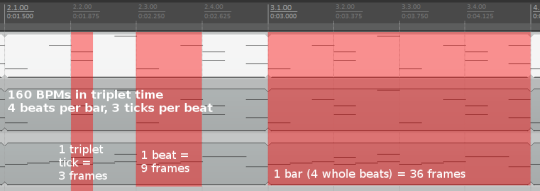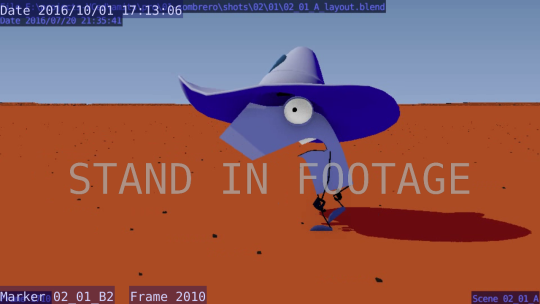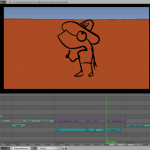It’s been 25 September to 1 October 2016. Calloo-callay! I spent much of the week in the Video Sequence Editor labouring over this particular sequence of shots. More on that shortly.
Blender 2.78 was released at the end of September and it’s full of new goodies. I’ll stick with Blender 2.78 running in “new depsgraph” mode for the rest of AMITS’s production unless Blender 2.79 releases with a killer feature like the fabled “make movie from scratch” button.
I spent this week doing scratch, timing and edit for Scene 3A and Scene 4. Editing is one more thing I have to learn to do, but it helps that one of my main reviewers (hi 3pointedit!) is a professional editor at least. 🙂 It was also a huge week which means a bumper post!
Let’s talk music!
Scene 3A is driven by the soundtrack – a soundtrack which is coming out of Pointy’s hat, much to his irritation. I did a temporary 160BPM triplet rhythm track and set to work cutting the action to music. This is the rhythm track:
https://soundcloud.com/quollism/amits-160bpm-is-9-frames-a-second-at-24fps
Why that particular tempo? I’m working at 24 frames per second, and 160BPM means a beat exactly every nine frames. If you cut that beat into three pieces, you get triplet time with exactly three frames per triplet.

Having a frame-timed rhythm track in the edit made it easier to think of the timing in terms of how many beats an action would take. One beat meant nine frames, two beats meant eighteen frames, four beats meant thirty six frames, etc.
I was editing to a “coarse” grid of nine frames (a beat) and a “fine” grid of three frames (a “tick”), so I “borrowed” three or six frames from a previous action to anticipate that action.
As long as I don’t make any cuts any finer than a tick, it means I can score at 160BPM in triplet time and get perfect synchronisation with what’s happening on screen – just like the old days when sound synchronisation was much cruder than it is now. (Check out my musical analysis of “Smile Darn Ya Smile” for some research I did about music in 1930s cartoons.)
Scene 3A runs into Scene 4. Pointy taking a step midway through Scene 4 sets up a big comedic moment, which led to this week’s other big job: transitioning out of the new scene 3A into the old Scene 4 properly.

Before I started, there were four cross-cuts in scene 4 where Pointy said more or less the exact same thing three times while Gronky decides what to say into the walkie talkie. It was a bit dull.
And Pointy didn’t have a reason to go for a walk at all.
I improvised about half an hour of “scratch” dialogue as Pointy, looking for what he might say between stopping the hat from making noise and going for a walk. Half an hour seems like a lot to pick through, but having a broad choice of variations is very useful at 1:30am when it’s too late to record new scratch.
Eventually I had him rant about Gronky’s idiocy for a bit and then catch himself, resolving to answer this negative energy with a blissful walk in “uninterrupted silence”.
Here is what forty seven minutes of Pointy complaining looks like as a waveform.

Then came editing. I wanted to try for quick cutting to up the pace, so I went back and forth between the two characters quicky. I had seven cross-cuts between Pointy and Gronky where Pointy got ranty about Gronky – mostly driven by splitting up Gronky’s actions to try to raise the suspense.
Unfortunately, it was a mess. The quick edits became too hard to keep track of as a viewer, though I discovered a much funnier way to cut the rough 3D footage I already had. So it wasn’t a complete loss.
The scene is now four cross-cuts between Pointy and Gronky and it’s still entertaining. I even got some funny shot set-ups, e.g. Pointy cherishes blissful silence aloud, cut to Gronky about to interrupt said silence with more silly noises. The scratch was cut together from three or four different takes. Pointy’s rant about Gronky’s apparent stupidity got cut from Scene 4 but has found a home in Scene 2. The footage will need re-animating to match the dialogue.

I’m in Amsterdam again later this month for Blender Conference 2016. I’d really like to have the movie in a rough but watchable state so I can show it to people. To do that I’ll need to tweak a few things on the soundtrack (mostly doing sound treatments on whatever noises are coming out of Pointy’s hat) and cover as much of the movie as possible as rough 3D. Much of the middle of the movie is back to being flatmatics again. I’ve got twenty five days left to either create or alter around thirty rough 3D shots. It should be more than enough time if I limit how much GTA V I play. 🙂
That’s it for this week. Thanks for reading and wish me luck!
